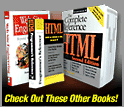

 |
 |
|||

|
Chapter 1: What Is Web Design?
A Clearer Definition of Web Design
So, after all this discussion, what exactly is Web design? It is obviously a very user-centered multidisciplinary design pursuit that includes influences from visual arts, technology, content, and business. A succinct definition follows.Web Design: A multidisciplinary pursuit pertaining to the planning and production of Web sites, including, but not limited to, technical development, information structure, visual design, and networked delivery.Because Web design is so multidisciplinary, it is often appropriate to pull ideas and theories from related fields. Indeed, we've been doing that even in the very first pages of this book. Some people, however, take this approach a little too far, developing their sites in a manner similar to print pieces or adopting so many software GUI interface conventions that the user becomes confused. While Web design borrows heavily from other design pursuits, there are significant differences. For example, the medium is very different than print because more function is provided—not unlike software. Delivery issues and content effects make Web sites different from traditional software applications as well. Web design isn't just adoption of old ideas. It's something altogether new. We shouldn't say the Web is totally different either. There are plenty of people who do that as well. The Web is so revolutionary, they say, that none of the old rules hold. This is complete nonsense. Despite the proclamations of pundits, new media forms have always adopted conventions from other forms and invented new ones of their own. Furthermore, no new form has completely eliminated any other. Radio, magazines, newspapers, television, and other entertainment media all continue to exist in some form or other despite emerging technologies and new media forms. The Web certainly isn't so new that we should throw out any valuable concepts we learned before. It does, however, have its own principles. We should strive to understand other media design concepts and modify them to fit the Web. The rest of the introduction will present some of the themes of Web design and conclude with a "roadmap" for the rest of the book. Next: Web Design Themes
|
Overview | Chapters | Examples | Resources | Buy the Book! |